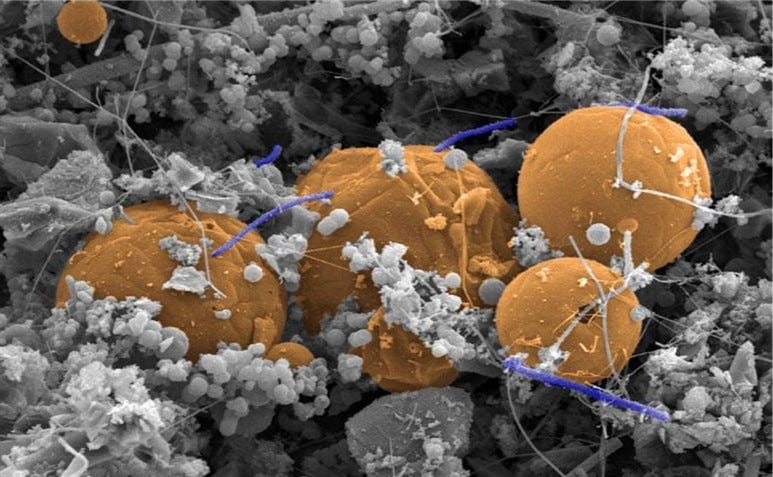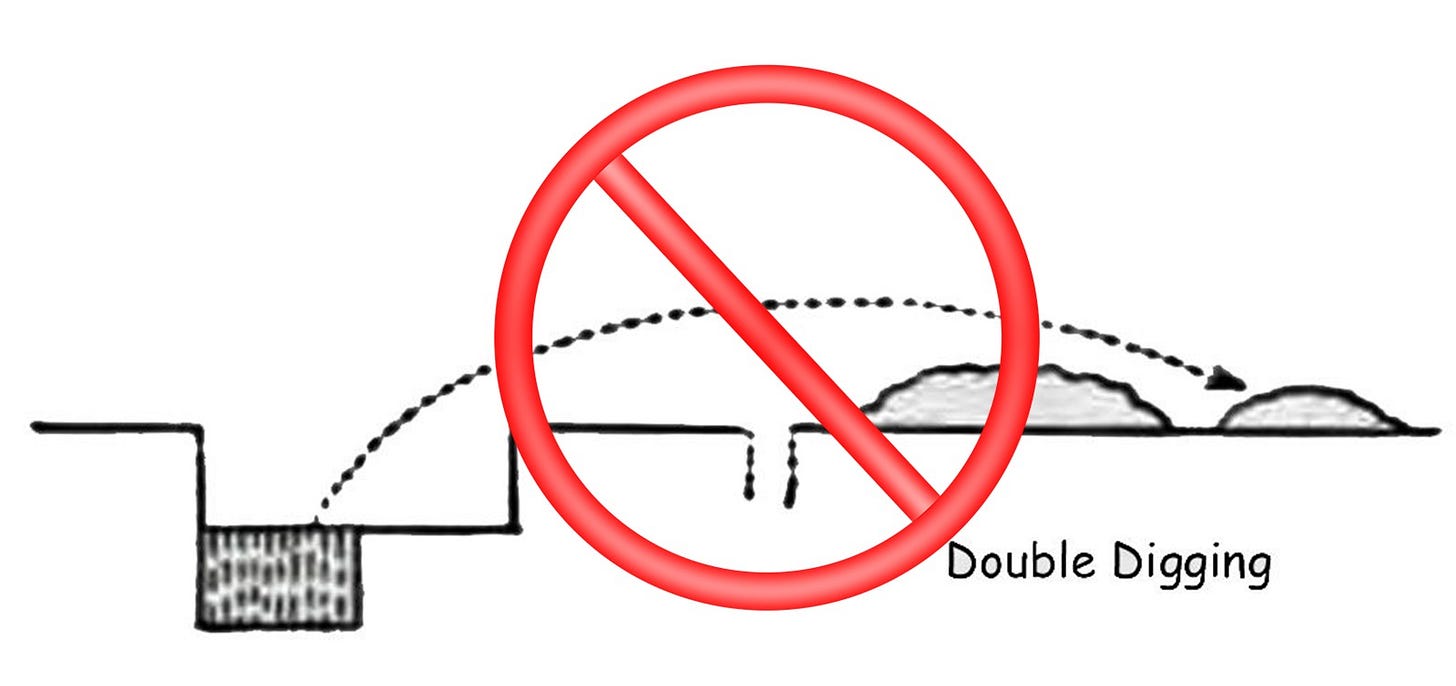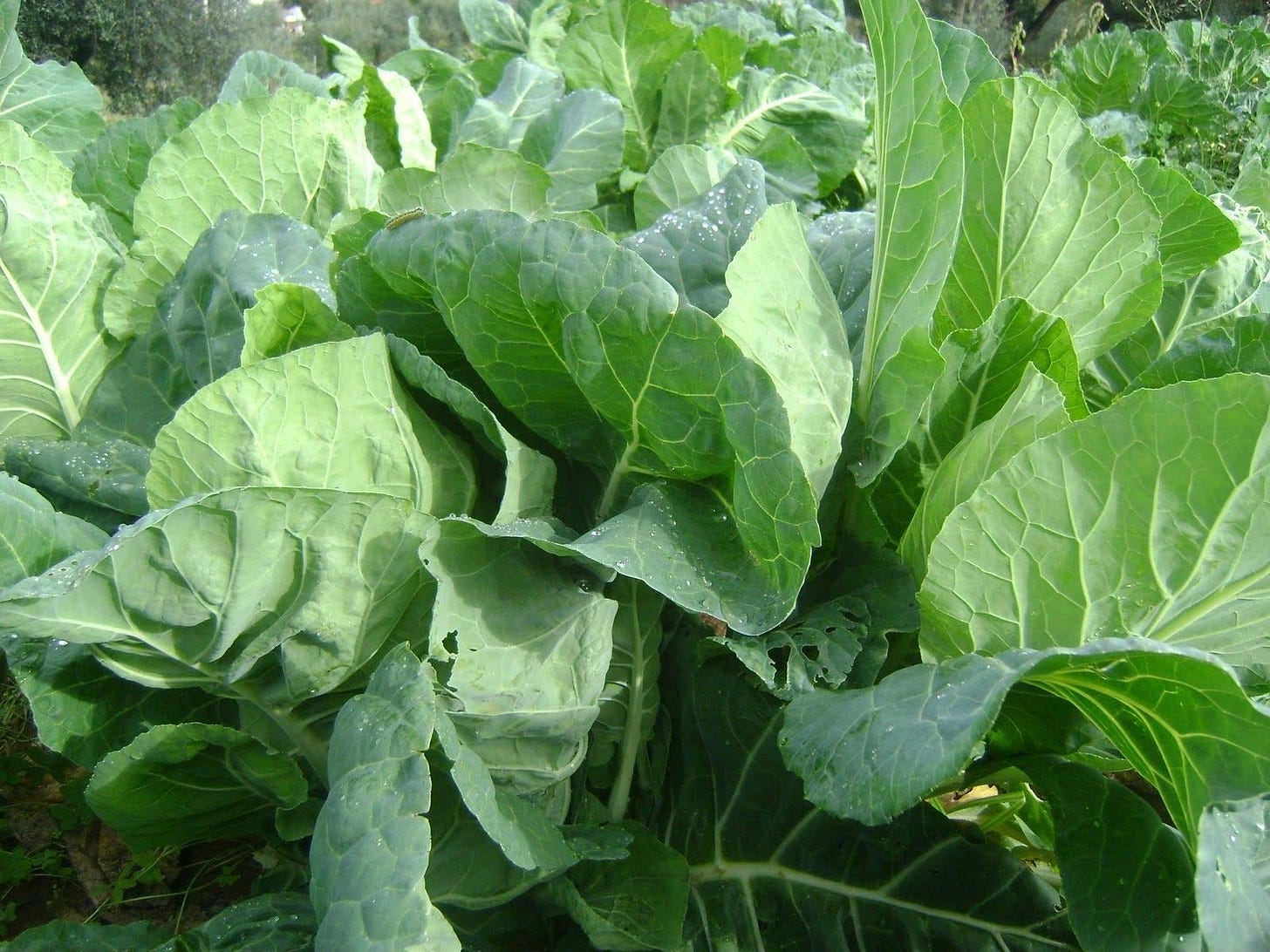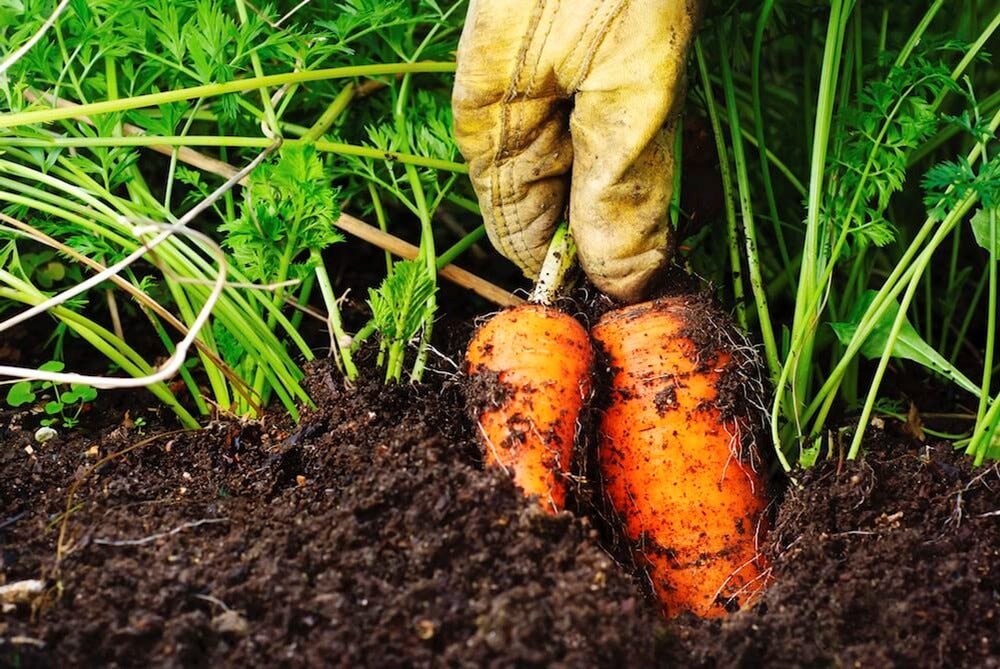WHEN THE EDAPHON GOES WRONG
How and Why the Soil’s Living Community Declines and What You Can Do About It
“Edaphon” is the collective term for all the living organisms within and on the very top of the soil. Although most people refer to this living body as the “soil microbiome,” that term more accurately refers to just the microscopic beasties, as evidenced by the prefix in the term.
Overall, this cooperative of life does pretty much everything a soil needs to maintain plants, to put it gardener-centrically.
I’ve covered the activities of the edaphon in detail in past articles. In summary, here’s what the edaphon, as a whole and when healthy, does NATURALLY:
They decompose organic matter. (Primarily bacteria but plenty of invertebrates, as well)
They aerate the soil. (Bacteria, fungi, and more)
They take nitrogen from the air and put it into the soil. (Primarily bacteria)
They dissolve minerals. (Primarily bacteria)
They prevent nutrients from being lost. (Primarily bacteria)
They produce “bioactive” compounds (e.g., vitamins, flavonoids, iron-chelating compounds, auxins, and growth-stimulating acids). (Primarily bacteria)
They help plants develop resistance to drought and other stresses. (Primarily bacteria)
They suppress soil pathogens by out-competing them for nutrients and space. (Bacteria and fungi)
They detoxify pollutants (Primarily bacteria)
They produce geosmin (part of petrichor). (Bacteria)
They free up nitrogen and phosphorus. (Bacteria and fungi)
They increase the water and nutrient absorption capacity of a plant. (Fungi)
They connect individual plants together and transport water and nutrients directly from plant to plant. (Fungi)
They work in conjunction with plants to regulate release of nutrient-rich exudates from plant roots. (Fungi)
They move carbon that they get from plant roots into the soil. (Fungi)
They create sugar-based “glues” that help develop soil structure. (Fungi)
They kill root-invading nematodes and many other soil-borne pests. (Fungi)
They release antibiotics into the soil. (Primarily fungi)
They produce compounds that are taken up by the plants, directly suppressing foliar disease organisms and/or helping kick-start a plant’s immune response. (Fungi)
They produce compounds that are taken up by the plant to protect the plant against pests. (Fungi)
They provide the “wiring” that helps plants “communicate.” (The well-known mycorrhizal fungi)
I’ve pointed out whether the activity was provided/performed by bacteria or fungi because each group responds negatively or positively to different stresses (in this case, garden cultural practices).
.
The good members of the edaphon and all their talents have for thousands of millennia helped plants germinate, grow, and survive all manner of stresses. Indeed, plants evolved from such organisms, with the aid of such organisms, and most of all, with organisms as part of them.
But we can’t mention the good guys without acknowledging their evil counterparts, the harmful microorganisms among the edaphon, the ones that can immobilize nutrients, produce toxic, stinky substances that adversely affect plant health (and your nose), and the ones that gardeners hate the most — those that induce plant diseases. Harmful microorganisms become dominant if conditions develop that are favorable to their growth, activity, and reproduction. That includes damage of the beneficial edaphon. Under such conditions, soil-borne pathogens can rapidly increase their populations with devastating effects on your garden.
When the human gut microbiome gets out of whack, doctors call it “dysbiosis” (pronounced diss-bye-oh-sis or dizz-bee-oh-sis) and it can lead to what is now well known as irritable bowel syndrome (IBS) or inflammatory bowel disease (IBD) as well as to many other, more insidious issues including cancer. When there’s an imbalance in the edaphon, plants similarly struggle with diseases and the garden as a whole suffers.
The most common dysbiosis is characterized by a predominantly-bacterial population versus the fungi-dominant population of natural soils or in the soils of a healthy landscape. Such a dysbiosis happens most often in lawns and in vegetable gardens and other continually “worked” plots. The good news in vegetable gardens is that most common seasonal-annual vegetables, as with most herbaceous plants, do well with this bacterial overload “(im)balance.”
Bacteria become dominant when:
Soils are high in nitrogen (e.g., fertilized lawns; those regularly amended with organic matter, especially manures, or have green crop residues [“green manures”] dug in; those amended with compost heavy with kitchen scraps).
Nutrients are readily available — such as happens with soil mixes containing pre-added nutrients or soils fertilized with synthetic fertilizers.
The soil is tilled at least intermittently but not necessarily constantly,
— Especially deep digging/tilling where organic material is incorporated into different soil horizons, such as with “bastard trenching” or, as it’s most commonly called, “double digging.”
Vermicomposting (using particular earthworms to break down the organic matter) is practiced.
Soils with these conditions usually start with plenty of organic matter but because of increasing bacterial activity, the organic matter is mineralized (decomposed) quickly, depleting soil nutrient reserve in a short time. Such soils become a treadmill of constant amending and fertilizing. Plus, the bacteria are not very efficient in their use of carbon; on average, 60 percent of the carbon they consume is wasted in conversion to CO2 and that is lost to the atmosphere.
On the other hand…Factors that suppress/depress bacteria:
Dry conditions
Very low pH (below 5.5)
Salinity
Bare ground
Soil compaction
Frequent or deep tilling
Lack of any organic matter
Use of bactericides including sulfur and copper products as well as homemade concoctions with alcohol or hydrogen peroxide in the recipe
Vegetable gardens, where the above “bacteria-beneficial” practices are all amplified, seem to be in a constant state of dysbiosis. In addition to the constant, overt tillage as mentioned above, there is seasonal “harvesting” (pulling up carrots, potatoes, turnips, and radishes, of course, along with just about anything and everything when it’s finished for the season) and pulling weeds (you don’t need to pull weeds to manage weeds). Both practices disturb the soil structure and all members of the edaphon. Occasionally turning the soil (along with some harvesting of root crops) does tip the scale toward the bacterially-dominated side, which is actually beneficial overall for most vegetables (albeit also favorable for weeds).
Leaving the soil bare for protracted parts of the year is a very common practice for vegetable gardeners. It goes to the thinking that there is a growing season (or seasons) for vegetables and then the garden (the soil) must “rest” or is “put to bed.” Although short term bare soils are repopulated by bacteria fairly quickly, long-term bareness slows down the bacteria cycle and can impact benefits.
Except in the case of certain seed inoculations (for nitrogen-fixing legumes), it is very difficult to build desirable populations of bacteria just by adding them to the soil. If populations of soil bacteria are low, it is probably because conditions are unfavorable.
The fungi missing from such worked soils primarily work on the woody, carbon-rich matter that breaks down slowly. Many of the fungi species are mycorrhizal, creating that all-important network of mycelium under the surface that is great for growing woody plants.
Fungi become dominant when:
Woody plants (trees and shrubs but sometimes other plants) become established and fill the soil with roots.
There’s a lot of “wood” on and/or in the ground, including mulching with wood chips and/or a natural covering of small diameter branches (less than three inches thick).
Cover crops are managed by “chopping and dropping” (cut down at flower bud stage and left in place as a coarse mulch).
Soil structure becomes developed.
On the other hand…Factors that suppress/depress fungi:
Cultivation and tillage — it physically severs the hyphae and breaks up the mycelial network as well as exposing much of it to the drying sun. Although the network can rebuild itself, continual tilling prevents proper functioning of the whole system.
Pesticides, particularly fungicides (of course), and even some herbicides.
Excessive use of manures.
High nitrogen, low carbon.
Use of concentrated N-P-K fertilizers.
Digging compost into the soil decreases mycorrhizal fungi.
Bare (fallow) soils (which can also reduce bacterial populations).
Planting crucifers (broccoli, cabbage, and the like; more later) and chenopodes (amaranths and the like; more later) in the vegetable garden (and maybe elsewhere).
Fungi are better than bacteria at carbon sequestration and building soil structure. They’re also better at taking in and retaining nutrients. This latter process involves the fungi consuming nutrients, thereby immobilizing them in their bodies and preventing nutrient leaching. During the course of their lives the fungi produce useful waste and eventually they are consumed by those further up the food chain, continuing the nutrient cycle in a form that is soluble to plants. Small amounts of nutrients are released into the soil at each stage.
Crucifers (cole crops) do not play nicely with mycorrhizal fungi. They tend to inhibit these fungi and when fungi do make any connection, the plant’s response is the same as it would be toward a parasite. The Brassicaceae (formerly Cruciferae) family includes a very long list of familiar and not-so-familiar vegetables: arugula, bok choy, broccoli, broccoli rabe, broccoli Romanesco, Brussels sprouts, cabbages, cauliflower, Chinese cabbages (many), collard greens, daikon, gai lan (Chinese broccoli), garden cress, horseradish, kale, kohlrabi, komatsuna, mizuna, mustard, radish, rapeseed (Canola™), rutabaga, tatsoi, tronchuda, and turnips.
Chenopodes, members of the Chenopodioideae (a subfamily of the Amaranthaceae and a mouthful), have similar effects. This family includes amaranth (orache), beets, chard, epazote, quinoa, and spinach. When these plants are included in a rotation, fungi numbers drop.
Some edibles — grains, legumes, alliums, and members of the Solanaceae (tomato, potato, pepper, and eggplant, for example) — thrive with a balanced mix of bacteria and fungi. Reduced tillage, mixed-species cover crops, diverse organic inputs (heavy on carbon, easy on nitrogen and phosphorous) promote the kind of balanced microbiome that suits them and yet is still favorable to all vegetables.
By the way, adding commercially packaged “mycorrhizal fungi” rarely works; it’s certainly unproductive in vegetable beds.
Many hybrid vegetables, those bred for high-input conventional growing systems, and some hybrid flowers may have lost some of their genetic capacity to partner with soil organisms for nutrient uptake, disease and pest resistance, and drought tolerance, along with losing their ability to attract the beneficial phyllosphere (the parallel community of life on the above-ground surfaces of plants).
MORE ABOUT TILLING THE SOIL
Nature has its own ways of “turning the soil” via that group of members of the edaphon called “bioturbators.” Although the balance of nature is sustained over the long haul in this manner, it is a mostly crude and messy process, certainly not a “gardening” method and not for short-term expectations. There are ways to streamline nature’s effects, some are fast while others require a bit of patience but produce better results.
But the gardening routine of repeatedly turning the soil (tilling, double trenching, “prepping the garden,” etc.) almost always has the opposite effect of what we expect. Even the innocent conventional acts of amending the soil and pulling weeds almost always do more damage than providing any expected benefits.
There are several layers and modules of edaphon, each with its own distinct community of species. This grand diversity — and layering — of species is key to a healthy soil.
Starting with directly on the soil surface, possibly the most important layer as far as gardeners are concerned, these are the species that focus on decomposing any organic matter that falls onto the soil either naturally or by human practice. This is why mulching is so important and why it must be done correctly. This is the “soil-mulch interface.”
Just below that, in this uppermost subsurface layer of the edaphon are mostly “seasonal” types, doing the jobs of further decomposition, processing mineral and organic nutrients, and making connections among the shallow-rooted plant species. Various mycorrhizal fungi species make their connections all the way down into the deepest layers of actual soil. Many biologists consider this zone, where natural, the archetypical, true biological “topsoil,” also called the “A-Horizon.”
While biological activity is greatest at this subsurface level, the edaphon extends at least as deep into the soil profile as do plant roots. With the commonly occurring variation in soil strata, there are wide ranges of moisture and oxygen levels, pH, and organic and mineral nutrient levels. These differences support soil microbial diversity that may be upwards of 1,000-fold greater than in any aboveground or aquatic ecosystems. Scientists have even found microorganisms deeper than plant roots, sometimes much deeper.
These layers take time developing the right population formula. Edaphon work in a balance, with different species, different types working together and toward a synergy that best suits the entire soil community, which includes the plants that grow on top of the soil. Such a balance takes time, often many years from a damaged soil. As with all of nature, when the edaphon is diverse and complex, it is healthier and it will do more to benefit the garden.
Turning the soil disrupts this layering, balance, and diversity. As mentioned, it has a serious impact on the fungal populations and, when frequently repeated, it can drop the bacterial population. Tilling particularly dislocates and damages those very important top two layers — the soil-mulch interface and the topsoil.
Repeated tilling degrades the soil structure — the “crumb,” the “tilth” — that provides enhanced moisture retention and movement, an arrangement conducive to best root growth and the all-important environment that best suits the edaphon.
Tilling also brings up buried weed seeds — the ones you thought couldn’t possibly germinate after ten years of being six inches down. These seeds now come to the surface where it’s warmer and usually moister, and boom, off they go.
Regular tillage stimulates the growth of bacteria and their consumers (e.g., protozoa, nematodes, proturans, symphylans), hence speeding decomposition and mineralization and, further, releasing some of the soil’s valuable stores of nitrogen and carbon into the air. More critically, tilling exposes and kills microorganisms causing even more carbon and nitrogen release.
“Breaking up the soil to aerate it” (why many till their soil, albeit misguidedly) increases water evaporation and releases carbon dioxide, a well-known greenhouse gas, into the atmosphere.
When the tilling is done to incorporate organic matter into the soil, there are additional problems. Actually adding organic matter INTO the soil isn’t necessary to get the benefits of organic matter. Bulk quantities of organic matter buried in the soil can lead to water movement issues. In some conditions, the burial of organics can develop into a restricted biolayer limiting drainage. When green leaves (or fresh kitchen waste) with waxy leaf coatings are added, these substances coat individual soil particles and restrict, or in some cases completely impede, water movement. The waxes particularly attach to sands and other coarse-grained soils, becoming “hydrophobic” (water repellent) at the soil surface.
When an abundance of organic matter is incorporated into the soil, including too much compost that still contains a lot of un-composted organic matter, the resulting population explosion of decomposers will rapidly use up the oxygen and the soil will go anaerobic for at least a short time. With reduced oxygen, anaerobic species take over and this then becomes anaerobic decomposition or, more properly, fermentation. Fermentation is usually accompanied by disagreeable odors of hydrogen sulfide and reduced organic compounds that contain sulfur, such as mercaptans (any sulfur-containing organic compound). Also included is lactic acid and alcohol, two chemicals that are toxic to plant roots. During fermentation (“anaerobic decomposition”), much less heat is generated than in aerobic decomposition and this lack of heat means a slower process. It’s more efficient and effective to make compost.
Despite these issues associated with tilling the soil and amending the soil, these two very common practices — tilling and its companion, amending — remain the biggest sacred cows of the gardening world.
Of course there are times when we must disturb the soil. We must plant a plant, remove a plant, transplant a plant. We must pull or dig up our potatoes and carrots and turnips. We are committed to raking in preparation for a new seedbed. In a sense, though, the whole of “gardening” is a disturbance of the soil and the natural environment. But it all can and should be minimized. Gardeners can take advantage of the natural and more subtle bioturbators in home garden soils, the native earthworms, the native ants, and even plant roots.
We don’t need to “till” the soil and we shouldn’t till the soil. In the garden, we can get the many benefits of organic matter and in a much more efficient and effective way by using a coarse mulch for the large spaces of the landscape and by making compost and using that compost as a mulch/topdressing between plants and in hard-working gardens such as vegetable beds. (For more on mulching, see “A CLOSER LOOK AT MULCHES AND MULCHING.”) Additionally, there’s the structure-fixing benefits of putting plant roots into the ground and leaving them there. The roots will help pull the soil particles into clusters to further develop structure (versus the un-clustering result from tilling) and the roots will help feed the mycorrhizal fungi (instead of breaking up this fungal network by tilling). If not a mulch, cover with seasonal cover crops for cover and for the roots.
THE MORE SERIOUS DYSBIOSIS
Although a bacterial soil may not be the best for the landscape and a fungal soil may not be the best for a vegetable garden, there are conditions that would be considered more serious. This is where the truly harmful microorganisms become dominant when conditions develop that are favorable to their growth, activity, and reproduction. That includes damage of the beneficial edaphon. Under such conditions, soil-borne pathogens can rapidly increase their populations with devastating effects on your garden.
The common gardening practices that degrade the beneficial edaphon — both bacteria and fungi — and often encourage the detrimental edaphon include:
Leaving soil bare. Bare soil is inclined to wash away, blow away, and become filled with weeds. It compacts and becomes water-repellent when the rain hits it or, somewhat conversely, hard rainfall breaks up the top structure making it even more water repellent. When bare soil is exposed to intense sun, nitrogen vaporizes, the soil gets too hot for root growth, phosphorus is leached downward, and soil microorganisms become stressed.
Growing the same vegetable or annual flower in the same place year after year — not rotating — allows root disease microorganisms to increase in population.
Compacting soil. Constant traffic and other actions that press down on the soil also break down soil structure and diminish oxygen-laden pore space.
Using synthetic fertilizers. Almost all synthetic fertilizers contain significant amounts of what is, chemically-speaking, salt. Although not to be confused with “table salt,” these salts, if applied improperly, can make soil crumbs (the structure) un-crumble along with directly killing good edaphon and/or encouraging bad edaphon. A more subtle but probably more harmful reaction: while bacteria can form favorable and complex interactions in the soil when nutrients are scare, they also decrease such interactions when nutrients are abundant. Overuse of such fertilizers leads to a treadmill which, by breaking down soil structure and dispersing edaphon, requires more frequent use of these fertilizers. When used in excess, they also cause what’s known as “fertilizer burn,” the browning generally at the tips of leaves. “Improper use” can be too much, too frequent, with minimal follow-up watering, on small plants, or piled in concentrated areas (a frequent application mistake).
Fertilization with high-phosphorous fertilizers. High phosphorus levels inhibit development of associations between plants and mycorrhizal fungi. This includes use of bone meal and many manures.
Feeding with fertilizers containing high amounts of copper (almost always in the form of copper sulfate). These are the products that are blue-green in color. Copper is anti-fungal. Copper is an essential element in plant nutrition but, not surprisingly, the more mycorrhizal fungi in the soil, the more the plants can get the copper they need from the soil’s mineral and organic components.
Use of pesticides, especially fungicides. A large part of the edaphon is beneficial fungi. Fungicides kill fungi. Even glyphosate, a pesticide that is not intended for weed control, inhibits an enzyme found in soil microbes. It reduces the mycorrhizae’s ability to colonize plant roots.
Watering during a region’s natural dry season. Native mycorrhizal fungi, essential to growing most native plants, succumb to warm wet conditions where Summers are dry and cold wet conditions where Winters are dry.
Raising the grade around trees. This all-too-common bad practice not only creates an area of bark rot at the base of the trees themselves, it dislocates the mycorrhizae — the vital fungal connections between tree roots and the surrounding native soil.
Removal of native topsoil. Native topsoil contains the adapted edaphon. Removing the existing top layer of soil, of course, eliminates these native beneficial organisms.
— Or somewhat conversely, burying the native topsoil with purchased “topsoil.”
Allowing weeds, especially grass weeds, to grow. Many weeds — rye grass and mustard being two of the worst — stifle or slowly wipe out the native mycorrhizal fungi. While some mycorrhizal fungi can inhibit weed growth, some weeds can kidnap the nutrients from other plants by tricking the fungi into giving up their load.
Reliance on drip (micro-)irrigation systems. These systems must run quite frequently to do their job of actually soaking the soil and hence do not allow for proper oxygen exchange. Anaerobic conditions ensue and along with that come the anaerobic root rot organisms that then out-compete the good guys. Drippers on unfiltered systems also allow salt to concentrate in spots, further causing damage and encouraging the wrong kind of microorganisms.
When a soil is treated unnaturally, it declines in overall health. And the farther away from natural we treat it, the more we rely on unnecessary products and now-disproven practices, the more it become the “crappy” soil we complain about. Oh, and then there’s that thing about the Earth.
.
I think most gardeners have come to the realization that our soils are packed with life. We’ve all heard the stats: soil is a highly biodiverse habitat, estimated to be home to nearly 60% of all species on Earth. A single gram (that’s 1/28 of an ounce!) of soil can contain potentially billions of bacterial cells, miles of fungal filaments, and thousands of different taxa. And yet, very few gardeners understand all the roles such life plays and the ultimate impact they have. Moreover, even fewer know how to enhance soil life or how to avoid damaging it. The bottom line here is that a natural, edaphon-rich soil can and will take care of your soil and your plants better than anything from a box or bottle or packet or …
.
To read more about the edaphon:
With more details on the activities of the edaphon: “WHAT’S LIVING IN YOUR SOIL - part 1”
With more on the mycorrhizal fungi: “WHAT’S LIVING IN YOUR SOIL - part 2”
.
© Copyright Joe Seals, 2025





